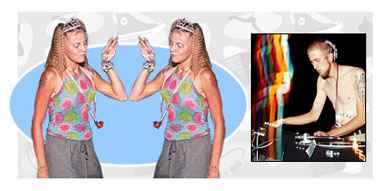Rave scene

Fashion Synopsis
So that's what happens when you refuse to grow up and can’t let go of Sesame Street.
Forget the decadence and catwalks of the discothèques… raves were about wide open spaces, trance-like techno music and universal acceptance. A response to the velvet rope clubs of the past, where money and style garnered entrance through the golden doors and along the red carpet, raves were affairs organized by DJs or a few house music fanatics whose sole purpose was to share the music. Raves were dance-a-thons for music fanatics, not scenesters, but eventually—like all cool underground vibes—the media got a hold of it and raving became the scene of the 90’s.
A new music trend was stewing in 1985 that was tired of the post-disco era of bad music and worse fashion. A new style of ‘acid-house’ music swept across the clubs of Europe, and hip Londoners brought the music back home to create what would be called the rave culture.
Raves were first publicized in England, where groups of young kids would gather in open fields or abandoned warehouses, holding impromptu all-night dance sessions. The group of hedonists danced till dawn to the new techno music that was raw, aggressive, and technologically advanced with samples, electronic music and synthesizers.
Most house music was laid down on a foundation of steady rhythmic beats, and in fact, the preferred beat was 120 RPM, that of the beating heart in the womb. And perhaps this ‘heartbeat’ rhythm was the catalyst for the baby regression—or infantilism—that permanently marked the rave culture.
In the beginning, the rave culture was little more than a group of kids joined together in appreciation for the new techno music and on a quest to dance. But as the scene broadened, it encapsulated an ever-increasing crowd, and three main groups emerged from the gathering: the post-hippy crowd, the club kids, and the sports fans. Each had very different looks, but all would eventually merge to create one homogonous style.
The post-hippies embraced tie-dye, smiley faces, and enjoyed drug-induced highs. The club kids brought their love of the costume party style of colored wigs, platform sneakers, toys and glittery makeup. The sports fans liked the extreme adrenaline and rush of dancing all night, and they wore soccer shirts and sneakers with oversized flare-legged pants. As diverse as the crowd was, each segment practiced universal acceptance, all under one roof of sound, thanks to a little-known (at the time) drug called Ecstasy.
The authorities cracked down on these giant parties of dance and drugs, and the groups banded together to fight for their right to party. This led to the underground, secret society that raves became known for. The rave scene became secretive, a tight-knit system of secret phone numbers, email messages, and word of mouth just hours before a rave was scheduled.
This new evolution of the rave scene created a new rainbow-bright land that was a combination of all the trends. Clothes were for comfort and visual stimulation, and commonly utilized childhood nostalgia with bold primary colors and playful patterns. Grown kids sucked on pacifiers, lollipops and candy necklaces (because Ecstasy made them grind their teeth violently), and wore baby doll dresses, baby barrettes, bibs and even alphabet block jewelry. They wore pigtails in their hair and carried stuffed animal backpacks, but showed off their bodies via tiny ‘baby’ tees that exposed their midriff.
Mickey Mouse gloves joined logo parody t-shirts like “Klubbers’ Nice Tripsies,” creating a blended affection for childhood comforts and adult playfulness. The ravers waved neon, glow-in-the-dark sticks around to create a streaming visual of color and stimulation, and wore reflective clothes to enhance the visual trip. The wallet chain concept of the streets was translated to plastic baby toy links as the chain.
Even the music revisited the past, as tunes like the Sesame Street theme song were sampled and placed with electronica techno backbeats. The ravers embraced the wide-eyed wonder of yesteryear in clothes, attitude and music. This baby regression returned the kids to the carefree days of childhood, but the use of drugs made it strangely bizarre, like a Twilight Zone episode where two very different worlds merged into one. The rave scene allowed us to return to childhood, even if it was only for one glorious night.
